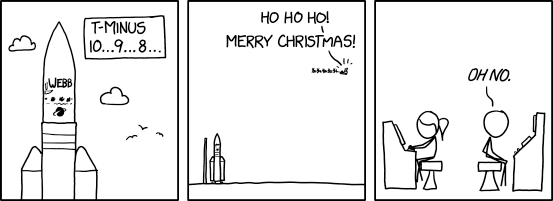Joy to the Cosmos!
NASA and space launch firm Arianespace have confirmed a launch date of December 25, at 7:20 AM Eastern Time, for the James Webb Space Telescope. On Thursday morning, the Ariane 5 rocket, with the telescope folded and stowed inside the payload fairings, left the assembly building at the launch facility in French Guiana and headed toward the pad. All indications are that, after more than two decades of planning, manufacture, setbacks, delays, cost overruns, and the eventual expenditure of over $10 billion, the most powerful instrument ever launched is finally about to take flight.
The complexity of the JWST is astounding. Rather than a single mirror, as in Hubble, Webb will have a 6.5m- (21’) wide mirror composed of 18 hexagonal gold-coated beryllium plates. Because the mirror is too large for any existing rocket, it will travel folded up, and deploy only when the telescope arrives on station. Unlike Hubble, that station won’t be in close orbit around Earth. Instead, Webb is bound for a point 1,500,000 km (930,000 miles) from Earth known as Lagrange Point 2 (L2), a spot where the gravity of the Earth and Sun are balanced so that anything near that spot can remain in orbit, holding position relative to Earth with minimum expenditure of energy.
It’s critical that Webb get away from Earth expressly because it’s an instrument that is designed to work mostly in the infrared—in the range of wavelengths we call “heat.” It’s going 1.5 million kilometers away, to an orbit where the Earth is eternally positioned between the telescope and the sun. There it will set, with its back to both Earth and Sun, as it deploys not just the folding mirror, but a whole series of massive sunshields, designed to keep heat from reaching the instruments. To work, Webb needs to be cold. Very cold. As in −223.2° C (−369.7° F) cold. Any warmer, and the delicate instruments will be overwhelmed; even damaged. One instrument has to be even cooler, just 7° C away from absolute zero, requiring an innovative “cryocooler” that cost $150 million to develop.
* * *
After over 25 years of development, the anticipation for Webb is enormous. Hundreds of scientists have constructed theories that are waiting for data from Webb to be tested. Scientists are anticipating the potential to learn about everything from the early days of the universe to the potential for habitable worlds and the nature of dark matter. To say that thousands of careers are dependent on what happens over the next few days is a big underestimate of just how vital this instrument is to astronomers and others around the world.
